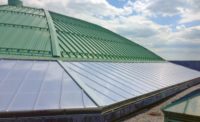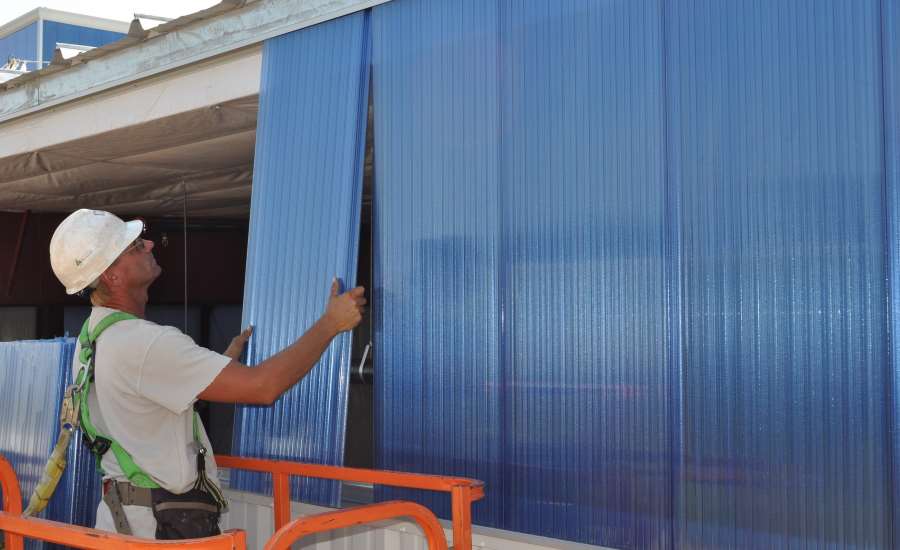Polycarbonate Glazing Systems and Commercial Buildings
The Many Benefits When it Comes to Energy Efficiency and Daylighting
















One of the most prevalent complaints building owners and facility managers receive is that the occupants are too hot or too cold. This is especially true for people seated directly next to a window or other daylight opening. They want the daylight, but they also expect an ideal interior temperature.
Meeting these needs, translucent cellular polycarbonate glazing (CPG) systems are used widely in new construction and renovation, and are a particular fit with metal building construction. Common building application types for CPG systems are warehouses, aviation hangars, school gymnasiums, college sports practice facilities, wastewater treatment plants, industrial facilities and other commercial applications.
Optimizing Comfort and Savings
Access to daylighting provides recognized benefits to health and wellness, accuracy and productivity. Spaces designed for daylight have demonstrated lower absenteeism, shorter hospital stays, higher test scores, improved retail sales and higher job satisfaction. Daylighting in commercial buildings also decreases the demand on electric lighting, which reduces the associated energy costs, emissions output and resource consumption.
CPG systems contribute to a sustainable, energy-efficient building envelope and comfortable, daylit interiors. Choosing the optimal amount of diffusion can be critical to the building occupants’ comfort and concentration. Too much light can result in “hot spots” with reflections on computer screens. Too little light can lead to poor comprehension and inaccuracies. Both extremes can cause eyestrain and headaches.
Most often CPG systems are specified with an opal color glazing, which delivers moderate to high diffusion for evenly distributed light, but also may be specified with a clear glazing for low diffusion and high light transmission.
Managing Light and Heat
Daylighting assemblies that utilize older technologies like Fiberglass Reinforced Plastic (FRP) often have a light transmittance range as low as 12-20 percent. With light transmittance this low, substantially more FRP material is required to maintain the same light levels as systems with a higher light transmittance. Also the addition of fiberglass infill insulation to these systems to achieve desired thermal performance could further reduce light transmittance.
In comparison, daylighting assemblies relying on CPG have a light transmittance range of approximately 45-70 percent. Compared to FRP, these materials provide a higher light transmittance per square-foot, improving the amount of daylight entering the structure, while reducing overall system costs and still achieving high thermal and insulation performance.
The high insulating and thermal performance of CPG systems further enhance building envelope performance by keeping the unwanted heat outside in warmer climates and the cold outside in cooler climates. HVAC load reduction can save building owners on both equipment costs and peak usage rates. Some utility providers also may offer credits or rebates to building owners that achieve significant reductions and continued efficiency.
When evaluating thermal performance for a building envelope’s translucent CPG wall systems, U-value is the preferred measurement, but R-value also may be specified by some. Where U-value measures the rate of heat transfer and a lower number indicates better performance, the R-value measures resistance to heat transfer and a higher number indicates better performance. Remember that an R-value does not account for all of the daylighting assembly’s components and facets that are represented in U-value calculations.
On average, a U-factor of 0.26 and an R-value of 3.84 can be expected for a CPG system with a thickness of 25 mm (1 inch). In contrast, a U-factor of 0.48 and an R-value of 2.08 would be typical of a double-pane, insulated glass unit (IGU) of the same thickness.
Installing with Ease
CPG systems can be field fabricated at the job site, or pre-fabricated in factory-controlled conditions to ensure the system performs as intended. CPG products are extremely versatile because the material is easy to fabricate and very workable. It can be cold-formed to a radius in the field.
Integral to proper installation and performance, CPG systems include aluminum framing members with:
- Deep glazing pockets to allow for thermal movement without disengagement of the panels
- Low-friction gaskets to allow the panels to move without pulling the gaskets from the frame
- Thermal movement or pressure plates designed to provide consistent pressure on the gaskets without over-tightening that might restrict the panels
Multiwall CPG systems rely on a tongue-and-groove profile. Joints, which have no battens of any kind, create a visually continuous wall. Some panel configurations allow the insertion of reinforcing bars that extend the length of the panel. These bars increase the panel’s spanning capability.
Compared with insulated glass units (IGUs) and other heavy glazing systems, the lightweight CPG daylighting assemblies require less material for structural supports, less fuel for transportation and less labor. A 25 mm (1-inch) thick piece of polycarbonate glazing weighs approximately 0.65 pounds per square-foot compared to 6.25 pounds per square-foot for an IGU of the same thickness. Because polycarbonate glazing material is formed through an extrusion process, CPG panels also can be provided at any length, as limited by shipping and handling.
When installation is more efficient, downtime is minimized, allowing building owners and occupants to be more efficient and productive.
Supporting Resiliency and Longevity
In addition to aiding efficiency, comfort and daylighting design goals, CPG systems also are recognized for contributing to projects’ durability, safety, and sustainability.
- Fire resistant – Polycarbonate will not support its own combustion; meaning, when the source of heat or ignition is removed, polycarbonate will cease to combust.
- Impact resistant – Polycarbonate is 250 times more impact resistant than an equivalent thickness of annealed glass and 30 times more than that of non-modified acrylic. Used in exterior wall and window systems, CPG systems’ high impact resistance helps protect against vandalism and storm damage.
- UV resistant – Because CPG systems constantly are exposed to the sun, they are co-extruded with a layer to resist ultraviolet (UV) radiation and eliminate yellowing. The UV protection repels almost 99 percent of harmful UV rays.
- Anti-reflective – To facilitate a better distribution of light throughout a building’s interior, anti-reflective CPG material may be specified to reduce reflections and glare. Its appearance resembles a matte finish. This option is also ideal for entertainment venues that want to project high-resolution images and lighting effects onto a translucent backdrop.
- Recycled and recyclable – CPG material and daylighting assemblies may be specified with up to 40 percent recycled content, depending on the project’s performance needs. At the end of its useful life on a building envelope, the polycarbonate panels and metal framing are 100 percent recyclable. CPG allows for the thermoplastic regrind to be used without diminishing the glazing material’s thermal performance.
- Durable – CPG systems involve minimal cleaning and maintenance. If necessary, the CPG tongue-and-groove assembly usually makes simple and quick work of repairs or replacements. For 50 years, European buildings have incorporated CPG systems in vertical wall applications. Some have remained unaltered for more than four decades. Manufacturers say that warranty claims are very rare.
Ensuring Best Practices
A common misconception is that performance attributes are independent elements. Please remember, changes required in a product to achieve one particular performance number often will cause changes in other numbers.
Working with the CPG system manufacturer early in a project’s design is the best approach to select and specify a system that meets the goals and requirements. Should any compromises be required to achieve better performance, aesthetic or value, it is easier and less costly to accommodate these earlier in the design process and with the expertise of the manufacturer.
When properly specified, engineered and installed, CPG systems offer a sustainable daylighting solution with high thermal performance to achieve the project’s economic and environmental goals.
Looking for a reprint of this article?
From high-res PDFs to custom plaques, order your copy today!













